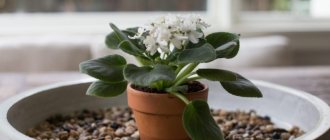Transfer
Deadlines
When, next to a rooted Saintpaulia leaf, daughter rosettes grow to sizes of 3-5 cm, this is a signal for replanting and dividing the plant.
Divide the young plants so that each one has 2 leaves with a growing point and several roots. To ensure that plants tolerate transplantation and division well:
moisturize the soil in the pot well; take out the plant along with a lump of earth; carefully shake off the soil from the roots by hand;
small children are separated from one another using a needle.
Transplantation of children.
For such tiny plants, pots are selected whose diameter does not exceed 4 cm. A mixture of soil and perlite is poured into them, planted to a depth of no more than 1 cm and kept under cover for about 10-14 days.
Technology
When the diameter of the rosettes becomes 1.5-2 times the diameter of the pot, the violets are transplanted to a permanent place of residence. For this:
select a pot with a diameter of about 6 cm with drain holes; pour a drainage layer on the bottom; add soil mixture for violets;
moisten the lump of earth in the pot where the plant is located; carefully remove the Saintpaulia with a lump of soil; plant the violet in the prepared pot; add soil mixture from the sides, slightly compacting the soil.
Priming
The soil mixture for Saintpaulia must meet certain requirements. The substrate must be:
- loose;
- fertile;
- moisture- and breathable;
- have a slightly acidic pH.
Many violet lovers prefer to prepare the soil for planting themselves. A mixture of turf, coniferous, leaf soil, compost, sand and peat is suitable for this. Vermiculite and sphagnum moss are used as leavening agents.
With big roots
Instructions on how to properly plant a violet with a leaf with a root more than two centimeters long:
It is necessary to stock up on suitable soil and a pot with a diameter of no more than 10 cm; Place a drainage layer on top and a little soil mixture at the bottom of the prepared pot; They spill the plant; Carefully remove from the old pot, cut off the lower yellowed leaves;
Very long roots can be shortened by 2/3 without harm to the plant, sprinkled with activated carbon; Plant a plant, add soil to the sides, compacting it a little;
Water the Saintpaulia.
Roots that are too long can be cut off.
Why and when is a transplant needed?
It is necessary to replant Saintpaulia, since the soil under it becomes salty, depleted, and the plant inevitably begins to hurt.
Ideally, this should be done once every six months, or more often. But used soil is not the only reason why violets should be replanted.
- At a certain period, “babies” are formed on leaf cuttings, that is, young rosettes with one growth point, where after some time an inflorescence sprouts. When this moment comes, competition begins between the “children”: the stronger ones put pressure and oppress the weaker ones. As a result, some possible future violets die without any benefit.
- In addition to damage to the rosettes, untimely planting is fraught with the risk that the mother leaf devotes all its strength to the rosettes and itself dies, which also leads to the death of the plants.
- Already separated “babies” are grown in small quantities of substrate, which is not enough for further development.
In order to understand whether the violet is ready for planting, you just need to carefully examine it. The children should form 3-4 pairs of leaves, of which at least 2 pairs must survive so that the plant can feed itself. It is more difficult for variegated violets to feed themselves, so having a sufficient number of leaves is very important for them. In order to speed up this process, it is enough to provide the young shoots with sufficient lighting. Thus, now we know when to replant the violet and we can proceed directly to the process itself.
Why don't homemade violets bloom?
There is an opinion among amateur flower growers that Saintpaulias, better known as violets, are not picky in their care and, when planting them at home, they count on the year-round availability of beautiful flowers of different shades and a pleasant aroma inherent in many varieties of this species.
Disappointment from the fact that the plant quickly develops leaves, but no flowers, occurs quite often, because caring for a violet involves more than just watering.
The reasons for the lack of flowering for a long time may be associated with the following factors:
Lighting: its duration and intensity directly affects the formation of the violet peduncle. Saintpaulia loves light and its lack causes improper development of the plant, in which flowering may not occur at all. When choosing a place for a young flower, make sure that it receives good sunlight, but so that it does not burn the leaves. Northern and western window sills are suitable. In the south, especially in the summer, greenery will suffer from excess direct rays. Remember! Regardless of where the plant is located in the house, it needs 10-12 hours of daylight, otherwise it suffers from lack of sun. To achieve this goal, a combination of natural and artificial lighting, if necessary, is well suited. A signal that Saintpaulia does not have enough light will be the stretching of the leaves - they will be drawn to the light source if the place for the flower was chosen incorrectly. Humidity and watering can also affect the natural development of flowers. Saintpaulia does not tolerate drought or excessive watering. In both cases, the plant loses its beautiful appearance and begins to hurt. Abundant watering leads to rotting of the root system, and its lack leads to drying out of the ground part of the flower. It is optimal to use a tray with water for watering, this way the violet will absorb the moisture it needs. The remainder needs to be drained
With the top watering method, you should carefully apply water under the roots, without touching the leaves and rosettes, as water can harm them. Important! Another important factor when adding water is its temperature: in no case should you use cold water directly from the tap . The flower prefers liquid at room temperature, which has settled well. In their natural habitat, violets grow near bodies of water, and they require a constant level of humidity for full growth
A good solution in the house would be a container of water standing next to the flower. You should not spray Saintpaulia with cold water, especially in winter; spraying is permissible only in the hot season, but only with warm water and not very abundantly. Incorrect room temperature can also lead to a lack of flowers, in particular, if it is too high, the optimal option for a plant year-round is 16-20 degrees. In order for Saintpaulia to delight with flowers, it must be fed frequently; in the absence of the required amount of fertilizer, the soil quickly loses nutrients and the plant has nothing to draw strength from to bloom. For violets, the composition of the substrate in which it lives is important. If its composition is incorrect, it will not only not bloom, but will also not be able to develop normally. The easiest way is to buy a substrate for Saintpaulia in a store, but you can prepare it yourself. You should not take hard soil; you must add baking powder and fertilizer to the mixture. Since the flower has a delicate root system, it needs a substrate that is light in consistency. The size of the flowerpot in which Saintpaulia is planted also affects flowering. You should not replant it in large and spacious pots, otherwise you will end up with an ornamental deciduous plant without flowers. Diseases and pests can also affect flowering, since if they are present, all the forces of Saintpaulia go to fight them. If traces of insect life appear on the plant, it should be treated immediately, otherwise it will quickly die. The same applies to signs of various diseases, which will be expressed in a deterioration in the appearance of the violet.
In addition to these reasons for the lack of flowering in the type of indoor greenery in question, you should also know the characteristics of the variety grown at home. Each variety has a certain flowering period and for some it is not long.
How to care for violets in winter
In winter, the main procedures for caring for violets are:
- Good lighting of the flower using fluorescent lamps or fluorescent lamps for up to 12 - 14 hours a day, alternating with the dark for up to 8 hours.
- Maintaining the ambient air temperature in the room at least 20 °C, without sharp fluctuations in one direction or another, without drafts during ventilation.
- Regular moderate watering with warm water up to three times a week.
- Increased air humidity in the room where your Saintpaulia lives. All ways to increase humidity are welcome - household appliances, containers of water, trays with wet expanded clay, wet towels on all radiators and other tricks that you can come up with.
- On cold windowsills under pots of violets there should be thick, at least 3 cm thick, plastic or wooden stands that protect the roots of the flower from hypothermia.
- Violet leaves should not touch cold glass windows, be careful about this.
Leaf with roots
Among people who love and grow violets, there has long been a certain confrontation: how to plant violets - with or without roots? But the majority is still inclined to planting material with roots. Let's look at how to properly plant a violet with a leaf and a root.
To plant a leaf, you need to prepare the soil with absolutely the same composition as for cuttings without roots
When preparing a violet leaf, you need to pay attention to the veins on the leaf. At least one vein must be present
It is from this that the root system will develop when you plant the cuttings in the ground.
Next, the cutting must be protected from various harmful bacteria with which it may be infected. To do this, prepare a special solution of copper sulfate. If this is not available, make a regular soap solution and rinse the cutting
It is important that the water temperature not only in this, but in other, for example, irrigation liquids, is at least twenty-five degrees. Cold water, again, promotes rotting
If you see that the rotting process has begun, simply cut off the infected tissue with a sharp knife.
There is no need to worry that the cuttings will not take root - the roots that appear will quickly begin to grow and hold the leaf in a straight position. Among the advice from experienced gardeners on how to plant violets, there is one essential one. After you have planted the leaf, cover it with film. This will create the greenhouse conditions necessary for development. We looked at the question of how to plant violets with leaves and roots. But there is another way.
Rooting and planting
Planting leaves with roots is done, naturally, after growing these same roots. And for this there are several ways of rooting. We will look at the following in detail:
- in water;
- in the ground.
In water
To root in water, you need to take a washed and scalded small container. Pour clean warm water into it. To prevent the leaf from rotting, take precautions :
- the cutting should be lowered into water by 1.5 - 2 cm ;
- it should not touch the walls of the vessel ; for this, the sheet is fixed in various ways;
- immerse a tablet of activated carbon ;
- to stimulate root growth, you can add 1 tsp honey or 1 tsp. aloe juice ;
- The evaporating water is added , keeping the water level at the same level.
Important! At the first signs of rotting, the water is drained, the container is disinfected, and the stem is cut to healthy tissue.
The appearance of roots can be noticed after 14-20 days. Planting violets with leaves with roots in suitable soil is done when roots 1-2 cm long appear on the cuttings.
In the ground
Planting cuttings directly into the ground gives a good effect For this:
- Small cups with a volume of no more than 5 cm are filled 1/3 with drainage mixture;
- Then add soil for violets and make a hole in it in the center;
- Soil mixed with perlite is added there to make it loose;
- Moisten the mixture and plant a leaf, deepening it no more than 1 cm ;
- Cover the top to create a microclimate, opening it slightly from time to time for ventilation and protection from rot.
Rooting in the ground.
Advice! You can use peat tablets for rooting. The leaves in them quickly take root and form young rosettes due to nutrition.
How to grow an adult plant from a baby?
You can raise children yourself or trust store specialists:
- If you grow the babies yourself, then when they appear on the leaf, do not rush to separate them. This is done when the rosette reaches a size of 4-5 cm and has a pair of leaves;
- If you bought a baby, then do not rush to transplant it into your pot. Give her time to get used to the ground. And after 2 weeks, replant.
Plants in the stage between baby and adult are called “starters”. At this stage, the plant is transplanted into fresh soil. At the same time, all the lower, small leaves are torn off, this contributes to the formation of a beautiful and regular rosette.
Stages of violet development.
There are several important points on how to grow a beautiful rosette:
- if the “sterter” is constantly flooded, an irregular rosette will form, the leaves will bend, and the middle will become denser;
- At the stage of rosette formation, lighting plays a very important role. In order for it to be of the correct shape, the pot with the plant is periodically turned towards the light;
- the first buds and stepsons that appear are removed, the violet is not yet ready for full flowering;
- with the further growth of Saintpaulia, temperature plays a role in the formation of a correct rosette.
Within 7-9 months after the baby has separated, you will have a fully formed plant.
Pruning violets
Sometimes, trimming violet leaves is not only possible, but also necessary. Let's start with the fact that the rosette of an indoor violet should look nice, proportional and consist of approximately three rows of leaves. The center of growth and development of Saintpaulia should not be overgrown with foliage.
If this happens to you, then simply remove the lower leaves, which have already begun to turn yellow and do not seem quite alive. Correctly plucking violet leaves from the stem is not difficult, just press with your fingernail at the base, and then, using twisting movements, completely remove the unnecessary leaf. If there are several such leaves, and as a result of such actions the flower’s trunk is exposed, then you can add fresh soil on top of the soil or transplant the flower deeper into new nutritious soil.
Do the same for pruning violets in the following cases:
- to remove excess leaves to stimulate lush flowering;
- to remove the top of an old violet to rejuvenate it - after a certain time, babies will appear on the remaining stump, which you use to propagate your specimen;
- to remove diseased leaves so that the disease does not spread to healthy ones.
How to choose soil?
Violets are very sensitive to the consistency of the soil in which they will grow. The soil composition should include a certain set of nutrients, and the pH level should tend to be slightly acidic. Also, the soil should be loose and well permeable to air.
The easiest option is to purchase ready-made soil from a specialized store. However, experienced gardeners say that purchased soil does not always meet the needs of violets, so it is best to prepare the substrate yourself.
To prepare the soil, soil taken from mixed forests, under acacia, hazel, linden, alder or pine, is perfect as a base. But oak groves should be avoided, since the tannins contained in such soil will inhibit the process of absorption of nutrients by the plant. An old anthill will also work well.
The soil collected from the forest must be steamed. To do this, pour water into a metal pan, sprinkle forest soil on top and heat it over the fire for about 15 minutes, stirring occasionally. Little water is required; it should only slightly moisten the substrate. After the earth has cooled, various additives can be added to it.
There are several main components, the use of which will help bring the substrate closer to the natural soil for violets.
The ratio of components in the soil can be different and depends on many factors, such as the place of origin of the main soil, the composition of the water that will be used for irrigation, and some others. In the average version, the composition of the soil for violets looks like this:
- 1 part of forest land;
- 2 parts peat;
- 1 part mixture of perlite and vermiculite;
- 1 part crushed sphagnum.
In addition, the composition may include sand, charcoal and coconut fiber. There is no need to adhere to a clear ratio of components.
Getting a plant from seeds
For a positive result of growing violets from seeds, you need to adhere to certain rules:
- Take a plastic container that is wide and not deep, and fill it with a thin layer, up to 3 cm, of special soil consisting of a mixture of peat and earth. You can buy ready-made soil or prepare it yourself, observing the proportions; there is no need to fertilize it at first. To ensure oxygen exchange, the pot must be placed on a special raised saucer; its design allows oxygen to pass through the drainage hole.
- Violet seeds should be purchased in specialized stores. Preparing seeds for sowing involves mixing them with sand in a one to one ratio.
- The seeds germinate well in a warm and bright place, so the pot should be covered with a transparent film or lid and placed in a bright place.
Direct sunlight and drafts should be avoided. On a note. The soil should always be slightly moist; a spray bottle works well for this. The ideal temperature for germination from seeds is considered to be 22-25 degrees Celsius. - The first sprouts from the seeds begin to germinate already on the 20th day, all this time the mixture should be moistened with a spray bottle.
The first picking of seedlings should be done when they reach a height of about half a centimeter and produce their first leaves.
Plant at a distance of 2 cm from each other in fertile soil, which should be fertilized with charcoal. The next transplant should be carried out as needed, when the sprouts begin to interfere with each other and are already planted in separate small containers. Before transplanting into a permanent pot, time must pass for the root system to strengthen.
The peculiarity of growing violets from seeds is that the new plants that sprout are of the same size and have multi-colored flowers.
From the video you will learn how to grow violets from seeds:
Typical germination mistakes
Negative results often occur during the first attempts to breed Saintpaulia. Reasons for failure:
- Leaf rotting. Most often it happens due to waterlogging, especially in winter. To speed up rooting, the cut is dipped in root material before being immersed in the soil.
- Water in rooting cups is disinfected with activated carbon.
- The rooted leaf became limp. You should place it in a greenhouse and reduce watering for a while.
- The leaf turned black. This happens due to excess moisture and sunburn. The pot should be placed in a greenhouse away from direct sun and dried.
Note! The general rule is: it’s better to dry it out a little than to fill it with soil. When rooting in water, you should change it to clean water every day and wash the glass
Propagation of violets at home
There are three main ways:
- Stepchildren and flower stalks. The young part is taken from the overgrown old individual and placed in a separate bowl with a prepared substrate. This allows the young to preserve the unique parental coloration.
- Cuttings or grafting. Take a violet leaf - dense, medium-sized, always healthy and not flaccid. It is cut off along with the leg, which is immersed in a jar of water. After the roots appear, the new plant is planted in the soil. This is one of the most common methods, but it does not always preserve the maternal color of the flowers.
- Seeds. Like many other plants, Saintpaulias can be grown from seeds. To do this, you need different-sex bushes installed nearby. After pollination, a queen pod appears on one of them. You should wait for it to dry completely. You can also use products from stores.
When to replant
Indoor flowers grow in containers with nutritious soil, which becomes depleted over time. If at first they can be fed, then this will not be enough for the overgrown specimens. There are other reasons that it is time to transplant the plant into another pot. A violet transplant is needed in the following cases:
- Store-bought flowers require replacement of the soil, as they are sold in peat. Flowers are transplanted into a new pot and different soil two weeks after purchase.
- Adult specimens with an overgrown root system are transferred to another pot, which should be slightly higher and wider.
- Violets with children are placed in separate flowerpots.
- The plant grows poorly, does not bloom, the leaves wither - these are the reasons why it needs to be taken out of the container and the roots examined. If they are normal, then replace the soil. The rotten roots are cut off, sprinkled with crushed coal, and the bush is planted in a smaller pot.
- A constant white coating on the surface of the soil indicates that it is time to replace it. First, you can try to remove the top layer and sprinkle it with sand. But if this does not help, the substrate is replaced.
Having realized that it is time to replant the violet, all that remains is to figure out when it is best to do it. It is not recommended to disturb plants at home during the dormant period. Replanting can be done in spring, summer and autumn, since violets rest in winter. Replacing the soil in winter is carried out only as a last resort if the plants show signs of disease.
Landing
The diameter of the pot for planting ordinary varieties of violets should not exceed 9 cm. The plant should be cramped in it.
Flowering will not occur until the root system has completely developed the soil.
Only the largest specimens are planted in containers with a diameter of 10-11 cm; for trailers and miniature varieties, 3-4 cm flowerpots are used. Reference! The diameter of the rosette should be three times the size of the pot.
Why might you need to rejuvenate a violet?
Over time, violets (another name for Saintpaulia) lose their decorative appearance, because plants, like all other living organisms, tend to age
It is important to know how to renew a violet. After all, only the first 2-3 years will delight Saintpaulia with abundant flowering
Blooming violets decorate our lives
The leaves of the lower tier of young plants live only 1 year. Then they curl up and die. The stem may become bare and woody. The inflorescences become small and inconspicuous, the former beauty disappears.
All this suggests that the violet is far from young, it’s time to renew it. This old lady can get her second wind. And if rejuvenation is carried out, then Saintpaulia will again delight with abundant flowering.
Only young violets delight with large flowers
Beginning flower growers have a question: how to prune a violet so that it blooms more? Leaves are cut with scissors or simply removed by hand without waiting for them to dry. If the violet has grown greatly in the pot and has become lush, such pruning is very useful: it promotes abundant flowering in the future.
Another good question: should you pluck the bottom leaves of violets? If the leaves are juicy and fleshy, this will not cause harm. But if the plant is weak and the leaves are already old, then the conditions are unsuitable. Saving leaves or, conversely, cutting them off will not help. An emergency transplant or taking a healthy leaf for propagation is needed.
Attention! The older the violet gets, the more it becomes like a palm tree, which has a bare stem and a flowering crown.
Reproduction
What to do if you want to get one or another variety that has an unusual flower color, doubleness, or is striking in size.
In the case of Saintpaulias, only propagation by leaves, that is, vegetative, is suitable.
The most optimal conditions for reproduction will be the spring and summer months.
Choosing a leaf for propagation
The choice of leaf for propagation must be taken seriously. You cannot take:
- leaves of a diseased plant;
- lower leaves. They are old and will need a lot of time to educate their children;
- sheets located near the outlet. Breaking off a leaf can cause damage to the violet's growing point.
For propagation, take healthy leaves from 2-3 rows.
For propagation you need to take leaves located in the second and third row . They should be medium in size, good color and firm to the touch.
Preparing the cut cuttings
In order for the broken cutting to take root and develop well in the future, it is necessary to carry out a number of manipulations:
- a sharp knife or razor is wiped with alcohol;
- the leaf is placed on the table and cut at an angle of 45 degrees, leaving the tip of the stem 3-5 cm;
- leave the sheet to dry the cut or dust the cut area with activated charcoal or charcoal.
If there is nothing sharp at hand, the stalk is simply broken off, leaving a stump of the required length.
When is the best time to replant violets?
If Saintpaulia has begun to bloom worse, and its stem in the lower part has become noticeably bare, it’s time to think about replanting. When growing on a windowsill, without additional lighting, it is advisable to have time to transplant the rosettes before active spring growth begins, that is, in December, January or February. February can be considered the deadline for transplanting violets, since in March the day becomes equal to night and timely transplanted plants are ready to bloom again. Violets grown on a rack with additional lighting can be replanted at any time. Even flowering rosettes. You just need to remove all flower stalks and buds at least a day or two before.
What is the right pot for violets?
We still hear discussions about the benefits of ceramic pots and the dangers of plastic pots. Without debunking myths, I will say that real professionals use ordinary, lightweight and, as a rule, inexpensive plastic pots.
As for size, for miniaturists this issue is practically not worth it - mini-varieties of Saintpaulia do not need successive transfers from a smaller pot to a larger one as they grow. They are transplanted into pots of the same diameter in which the violets grew before. Some people gravitate towards very tiny containers with a diameter of 5 cm, but I prefer standard “tall” pots with a diameter of 5.5 cm. Despite the fact that the difference in diameters seems insignificant, the volume of such pots can differ by a third.
The maximum size for semi-miniature violets can be considered 6 cm (the volume is 60% larger than with a diameter of 5 cm). In such pots it may be easier to maintain uniform soil moisture, but the rosettes may grow larger, which will be their disadvantage.
What do the roots of Saintpaulia tell you?
Transplanting violets (Saintpaulias) is an excellent time to inspect the root system. Based on its condition, you can analyze its care and understand whether the mixture for planting was prepared correctly last time. The most common mistakes that can be identified at this stage are too large a pot, excessive watering and a lack of cultivators in the soil mixture. Ideally, the lump of earth should be completely penetrated by thin roots, and the living white tips of new growing roots can be visible on its outer part. If on the third day after watering the soil remains excessively wet and pieces fall off the roots, which are difficult to identify, or the soil has a characteristic sour smell, this is a signal to change the care regimen. In this case, it is better to use not a traditional transplant, but complete re-rooting.
Timing and methods of the procedure
The optimal time for replanting violets is March - the month when the vitality of the plant reaches its peak. Many people advise focusing on the lunar calendar and planting a flower on the waxing moon. If there is an urgent need, you can move it to another container in the fall.
In summer and winter, the survival rate of violets in a new place is very low. This is significantly influenced by the weather conditions of each season: increased air temperature and insufficient sunlight.
The procedure absolutely cannot be carried out during the flowering period of the plant, otherwise there is a possibility that it will drop its petals and get sick. The only justification in this case can be that the violet is heavily flooded with water and its roots will inevitably rot, remaining in the same substrate. Then the goal of saving Saintpaulia justifies the means, and transplantation becomes an exceptional opportunity to save the life of the flower.
Before starting the procedure, the plant must be removed from the flower stalks manually and the wounds must be lightly powdered with activated carbon.
There are several ways to transplant violets:
- Replanting with complete soil replacement. It involves planting in a pot filled with fresh nutritious soil mixture.
- Transshipment method. It consists of removing the plant from the old container without disturbing the integrity of the earthen lump enveloping the root system, and carefully transferring it to a new prepared pot. The resulting voids and unfilled volume are filled with nutrient substrate. Finally, the flower is watered with settled water at room temperature. This method is used to replant a young, overgrown plant if the soil in the current pot has not yet become depleted and does not contain fungi or infections.
What you need to plant violets
To grow and propagate Uzambara violets at home, you will need to stock up on:
- flower pots of various sizes;
- plastic cups or small bottles for rooting cuttings;
- suitable soil mixture or components for making your own substrate;
- complex fertilizers;
- fluorescent lamps for illuminating plants in winter.
Containers for Saintpaulias are usually used small, flat type, due to the fact that the roots of violets are located quite close to the surface. Flower pots are selected three times smaller than the diameter of the plant's rosette - only in such rather cramped conditions does the Uzambara violet feel best and bloom more luxuriantly. If you are going to root a cutting, disposable plastic cups (necessarily with holes in the bottom) or medicine bottles will do.
There should not be any special problems with the soil mixture, since in any flower shop you can now buy a special soil for violets, light, loose and breathable. But some gardeners are very sensitive to the question of how to plant violets, preferring to mix the soil for their plants themselves from turf soil, leaf and pine humus, peat, river sand and sphagnum moss. You can find many different recipes for soil mixtures on the Internet - whatever you choose, try to ensure that the soil is not heavy and allows moisture and air to pass through well; for this, be sure to use vermiculite, sphagnum moss or perlite. You can also use foam chips.
It is advisable to immediately add superphosphate fertilizer to your own prepared soil mixture. In the future, it is recommended to apply fertilizers when buds form on the violet and after it blooms.
And of course, do not forget about additional lighting, without which Saintpaulias will be uncomfortable in the cold season, when daylight hours are very short. Artificial lighting is used for 10-12 hours daily, fixing the lamps above the plants at a distance of at least 20 cm.
Transplanting violets step by step with photos
To understand how to properly transplant a violet, check out the methods of replanting a flower at home:
- With complete replacement of soil. If the flower is sick or if it is necessary to replace the depleted substrate.
- With partial soil replacement. After purchasing in a store and when replanting adult plants, carefully shake off some of the old soil from the roots.
- Transshipment during flowering so as not to disturb the roots, and the violet bloomed well even after transplantation.
Whatever method is chosen, you must first select a suitable container, soil mixture and properly prepare the flower.
Choosing a pot
Which pot to transplant into depends on the age, size of the violet and the reason for transplanting:
- For healthy adult plants, choose containers 10 cm high. The width of the new pot should be 2-3 cm larger than the old one so that the roots have room to develop.
- Violets with bare stems are transplanted into a higher pot. Its height is selected taking into account the fact that the stem should be covered with earth right up to the leaves.
- For young rosettes, a diameter of 6 cm is enough. If you plant them immediately in a large pot, they will not bloom for a long time. Flowering will occur only after the roots have grown and filled the entire bowl.
- Sick specimens whose rotten roots have been cut off should be planted in the same container or a smaller pot.
Violets look very beautiful in ceramic pots. However, the soil dries out quickly. Therefore, plastic pots with drainage holes are preferable.
You will be interested to know: Growing eustoma at home in a pot from seeds: planting and care at home with photos and videos
Please note that pot heights do not include drainage. It is necessary to add about 2 cm more to the drainage layer.
Containers that will be reused are first washed with soap and rinsed with a solution of potassium permanganate.
Soil selection and preparation
The substrate for Saintpaulia from the store does not need to be prepared in advance. It is nutritious and completely ready for use.
The soil for violets is prepared independently using black soil and peat (5:3), to which one part of coarse river sand is added. A prerequisite for self-prepared substrate is preliminary disinfection in any way (for example, heat it in the oven, spill it with a solution of potassium permanganate).
You need to stock up on not very large drainage (perlite or expanded clay).
Preparation and transplantation
Water indoor plants at least two hours before transplanting. The earth ball must be completely moistened so that it does not fall off the roots and the flower can be easily removed from the pot.
Immediately before the procedure, the violets are carefully removed from the pot and examined:
- cut off the lower old, damaged, yellow or diseased-looking leaves;
- remove easily crumbling soil from the roots;
- very long roots are shortened by a maximum of a third of their length;
- in diseased plants, the substrate is completely removed, rotten roots are cut off and sprinkled with coal;
- There is no need to shake off the soil of blooming violets so as not to disturb the roots.
How to transplant a violet into another pot at home step by step:
- Place a 2 cm layer of drainage on the bottom of the bowl for large plants and 1 cm for small ones.
- Cover the top of the drainage with a layer of 2-3 cm of soil. In small pots a little more than 1 cm.
- Place a flower on top along with a lump of earth.
- If the soil has been removed from the root system, the roots need to be carefully spread out on the soil in the pot.
- Place soil around the roots and stem, under the leaves, down to the bottom leaves.
You will be interested to know: Gloxinia: care and cultivation at home
- Water the soil a little at a time slowly. If it settles, add more.
- Check to see if the transplanted violet is wobbly. If necessary, compact the substrate a little very carefully, add a little more soil and sprinkle vermiculite on top. Sphagnum moss can be used as mulch.
Make sure that the core of the violet is not covered.
After transplanting, keep the flowers in the back of the room for 2-3 days, and then you can put them in their place. For better survival, put bags on top.
It is best to grow violets in a well-lit place without direct sunlight and away from heating radiators.
You can tell when you need to water the flowers after transplanting by the dried top layer of soil. Check carefully with your hand, and if the soil near the roots is still wet, it is too early to moisten it. In large pots, 2-3 cm of the top layer of the substrate should dry out, after which you can start watering.
Getting to know the violet
Saintpaulia is the second name for the Uzambara violet. The number of varieties of this beauty is constantly growing, delighting with new colors and shapes of both the flower itself and the leaves. They come in single-color and multi-color, with patterns and fancy borders. There are two types of inflorescences: fringed and double. Lovers of this plant participate in exhibitions where they can buy the flower they like.
Some believe that violet is capricious and should not be messed with. In fact, the violet just requires proper care, and then you will become friends with it forever. What you should pay special attention to:
- priming;
- illumination and temperature;
- watering;
- nutrition.
Lighting and temperature
Many people know that violet is demanding in choosing a suitable window sill. But if she has chosen a place, she will give constant joy in the form of abundant flowering. The plant needs enough sun, but without direct sunlight. South-facing windows are unlikely to work unless using shading techniques. It is best to have diffused light with a large time interval of illumination.
Often the violet is placed in the kitchen - there is high humidity and a lot of light, which she loves very much. In winter, plants suffer from poor sunlight, so it is advisable to illuminate them with daylight lamps for up to 14-15 hours.
Comfortable temperature for violets:
- in summer – 20-24 degrees;
- in winter about 18 degrees.
The flower does not tolerate drafts, so when ventilating they need to be moved to another window.











